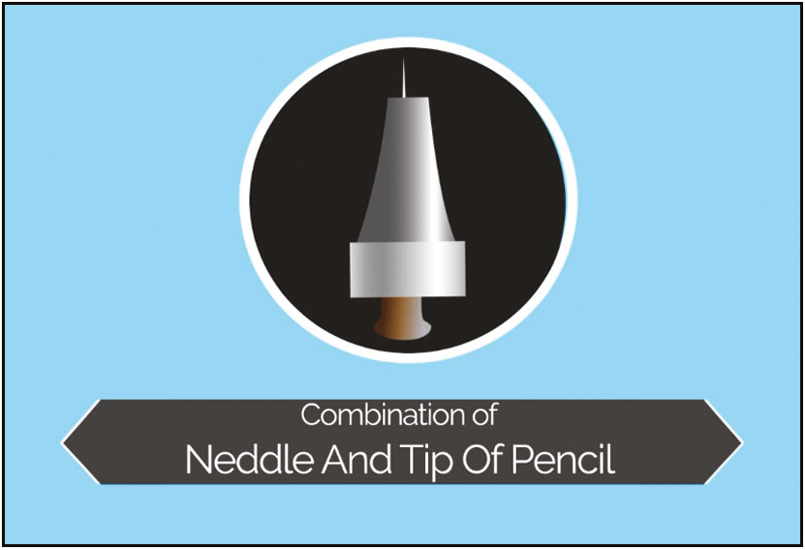Translate this page into:
Modification in 26-gauge Needle
Address for correspondence: Dr. Vaishali Laleshkumar Nahata, Belle’ Skin Care & Laser Clinic, Ahilyadevi Holkar Marg, Mumbai Naka, Nashik 422002, Maharashtra, India E-mail: vailesh@gmail.com
This is an open access journal, and articles are distributed under the terms of the Creative Commons Attribution-NonCommercial-ShareAlike 4.0 License, which allows others to remix, tweak, and build upon the work non-commercially, as long as appropriate credit is given and the new creations are licensed under the identical terms.
This article was originally published by Wolters Kluwer - Medknow and was migrated to Scientific Scholar after the change of Publisher.
Abstract
Abstract
Needles are the most widely used medical device. A 26-gauge hypodermic needle is a simple hollow instrument; however, its use in dermatologic procedures are numerous. Needle can be used as a cutting instrument and can be used as an extractor. Here, I present a simple innovation that makes the grip of fingers firm over the needle and thus extraction of lesions becomes easy and faster. Insert the tip of the needle in the front portion of the lead pencil and one can hold the needle like a pen which makes the removal of lesions easy. The front portion of a pen is made up of metal and thus it can be sterilized in an autoclave. A video demonstration of this innovation is attached.
Keywords
26-gauge needle
extraction
lead pencil
INTRODUCTION
Innovation is any change Big or Small that makes a difference.
Thomas Smith
A 26-gauge needle is a favorite and commonly used instrument among Dermatologists. As its diameter is less, it is less painful and thus can be used as a cutting instrument as well as an extractor. Charles Hunter, a London surgeon, is credited with the coining of the term hypodermic in 1858. The name originates from two Greek words “Hypo” meaning under “dermic” meaning skin.[1]
A 26-gauge needle is a very thin hollow tube with outer diameter (OD) of 0.47 mm and an inner diameter (ID) of 0.13 mm. The hole measures 0.45 mm and it is 13 mm long. It is used as an extractor, that is, with the help of needle a nick is made at the top of the lesion; thereafter, the contents are evacuated by moving the needle in a parallel fashion. It is used in the extraction of:
Milia
Small retention cysts
Comedones
Molluscum contagiosum
Small foreign body.
It is easy to remove if the lesions are few. But the challenge in these procedures is tackling multiple lesions. Following are the shortcomings of using a 26-gauge needle while extracting multiple lesions:
There is always pain, anxiety, needle phobia which makes them unpopular with children and adults.[23] Therefore, a less painful and convenient system is required.
Increasing needle length is also expected to increase pain. The likelihood of bleeding also increases.
As the needle is long, the contents might pop out and litter the attire.
To overcome these shortcomings, the following modifications have been suggested:
A lead pencil has a tip made up of metal and is plated with chrome from the inner side.[4] This tip can be sterilized by autoclave [Figure 1]. 26-gauge needle [Figure 2] is inserted from behind in the tip of a lead pencil. Only the tip comes out of the hole. The modified instrument [Figures 3 and 4] with 26-gauge needle has the following advantages:

- Tip of the lead pencil

- 26-gauge needle

- Combination of needle and tip of the pencil

- Actual photograph showing combination of needle and tip of the pencil
The base gives a good grip and thus multiple lesions can be tackled in the same sitting.
The depth of the needle is controlled while extraction and thus it is relatively painless.
The needle does not kink.
The friction is minimal; thus, the needle does not become blunt immediately.
Thus, this technique is easy to master and is very affordable [Video 1].
Financial support and sponsorship
Nil.
Conflicts of interest
There are no conflicts of interest.
All videos available online www.jcasonline.com
REFERENCES
- Fear of needles and vasovagal reactions among phlebotomy patients. J Anxiety Disord. 2006;20:946-60.
- [Google Scholar]
- Reducing injection pain in children and adolescents with diabetes: A review of indwelling catheters. Pediatr Diabetes. 2004;5:102-11.
- [Google Scholar]
- Innovation, diffusion and safety of a medical technology: A review of the literature on injection practice. Soc Sci Med. 2005;60:1133-47.
- [Google Scholar]
- “Pencil” (U.S. Patent No. 1,552,123 issued September 1, 1925). Available from: http://autopointinc.com/about-us.






